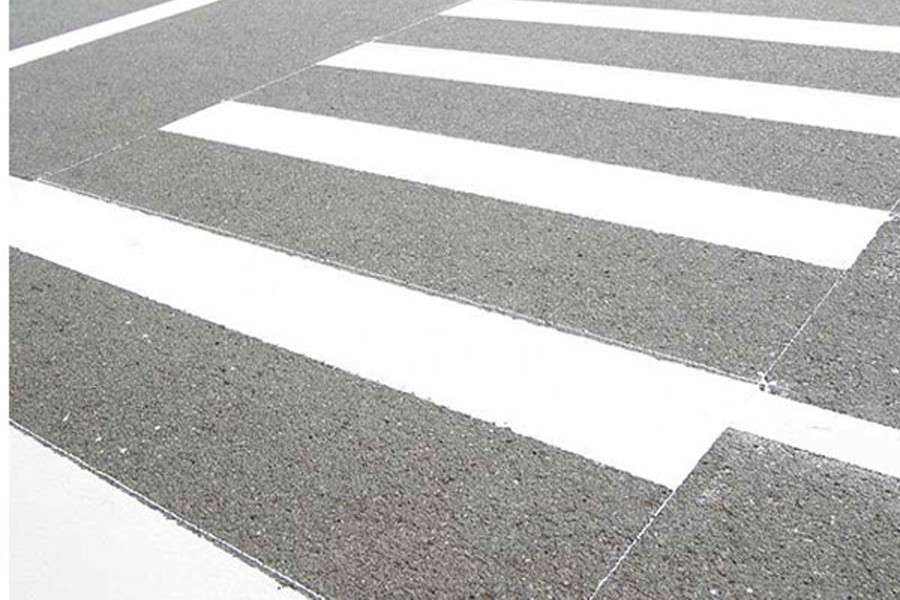
Published :
Updated :

The death of Abrar Ahmed Chowdhury, a first year student of Bangladesh University of Professionals on March 19, 2019, caused by a speeding bus at a zebra crossing at Badda, Dhaka sent shock waves across the country. Enraged young people, especially school and college-going students, started demonstrations at several points of the capital immediately after the incident. The unfortunate part of the event is that Abrar, himself a 'safe road' campaigner, was not at all wrong in using the zebra crossing - a very useful traffic tool across the world.
Zebra crossing was first introduced in the UK around the mid-1940s. Though foot over-bridges, underpasses and skyways became popular in the West and the developing countries later, zebra crossings did not fade into the woodwork as constructing over-bridges, underpasses and skyways were costlier and required more space on the existing roads and footpaths.
The trend was similar in the cities of our country until the 2000s. Since mid-2000s till date, zebra crossings have been facing a seemingly increasing aversion from speeding vehicles as well as concerned authorities.
Most of the zebra crossings in the country are placed a few feet before the traffic signal posts. The idea is that once the traffic comes to a stop at a traffic signal, the pedestrians will use the zebra crossing to move to the other side of the road.
But in most cities, especially in Dhaka, the drivers of private and public vehicles do not want to stop and wait at the crossings. These vehicles intentionally speed up near the crossings. Unsuspecting pedestrians or those already on the move are often hit by these vehicles causing injuries and fatalities. Even rickshaws and CNG-driven scooters do not want to wait for the pedestrians to cross at such spots, though it is the latter's right.
If pedestrians complain, traffic policemen often point to the nearest foot over-bridges. However, scaling the stairs of the over-bridges is quite difficult for many elderly people and those who are physically-challenged. For them, zebra crossing is an apt traffic tool.
As the concerned authorities in the country felt that zebra crossings are slowing down the traffic and leading to traffic congestions, the number of such crossings was replaced with foot over-bridges and underpasses. But this has not stopped some pedestrians from moving on the roads to cross the streets, often endangering their lives. Nationwide drives by the traffic police department over the years could not break this dangerous habit of some pedestrians. This has led to many accidents and road mishaps.
Most developed cities of the world have the 'Pushbutton Crosswalk' signals. At these signals, the pedestrians come to the side of the footpath, where a pole stands adjacent to a traffic signal. The pole has a 'push to walk' button. Once the pedestrian pushes the button, the traffic signal goes 'red' thus stopping the incoming traffic. As soon as the vehicles stop, another signal on the other side of the road lights up prompting the pedestrians to walk and cross over.
In some countries, these crosswalk signals have a timer, which gives pedestrians information about the time left to cross the street before the signal for the vehicles go 'yellow' and then 'green'.
Last year, the first 3D zebra crossing was unveiled in southern China.
In Bangladesh, children are still taught the 'kerb drill' in schools. The kerb drill is a set of precautions taken to cross the street. The kerb drill wanted pedestrians to look left, then right and again left to ensure that there are no vehicles on either way before crossing the road.
In the developed countries of the world, the kerb drill was replaced with more updated traffic precautions for pedestrians. For example, the UK replaced the kerb drill with Green Cross Code around the 1970s. Under this, pedestrians are required to:
- THINK: Pedestrian needs to find the safest place to cross the road.
- STOP: The pedestrian needs to stand and wait on the pavement before crossing.
- USE YOUR EYES AND EARS: The pedestrian needs to look and listen for traffic.
- WAIT UNTIL IT IS SAFE TO CROSS!
- LOOK AND LISTEN! The pedestrian should make sure that there is no incoming vehicle.
- ARRIVE ALIVE! Pedestrian will walk across the street.
If these practices and precautions are localised and applied besides generating awareness in Bangladesh, then the safety of pedestrians will be enhanced. Accidents on the road are likely to come down further if existing traffic laws and regulations are strictly followed by all stakeholders and monitored by the concerned authorities.


 For all latest news, follow The Financial Express Google News channel.
For all latest news, follow The Financial Express Google News channel.